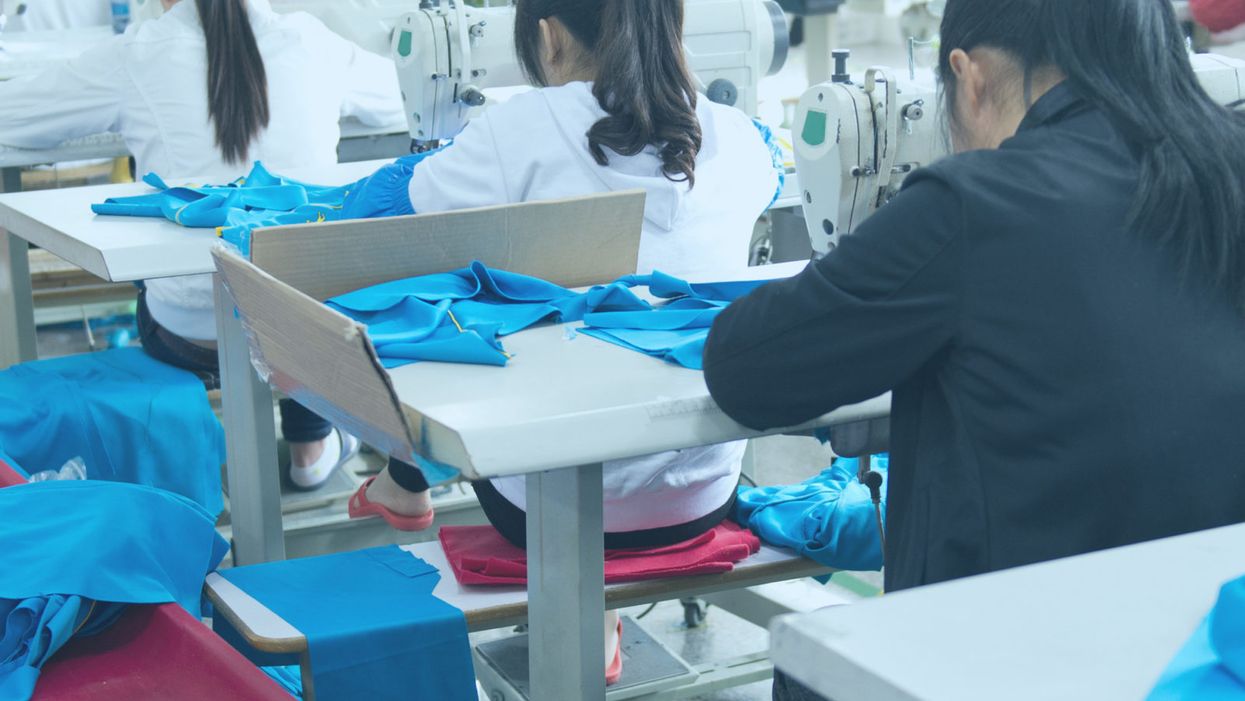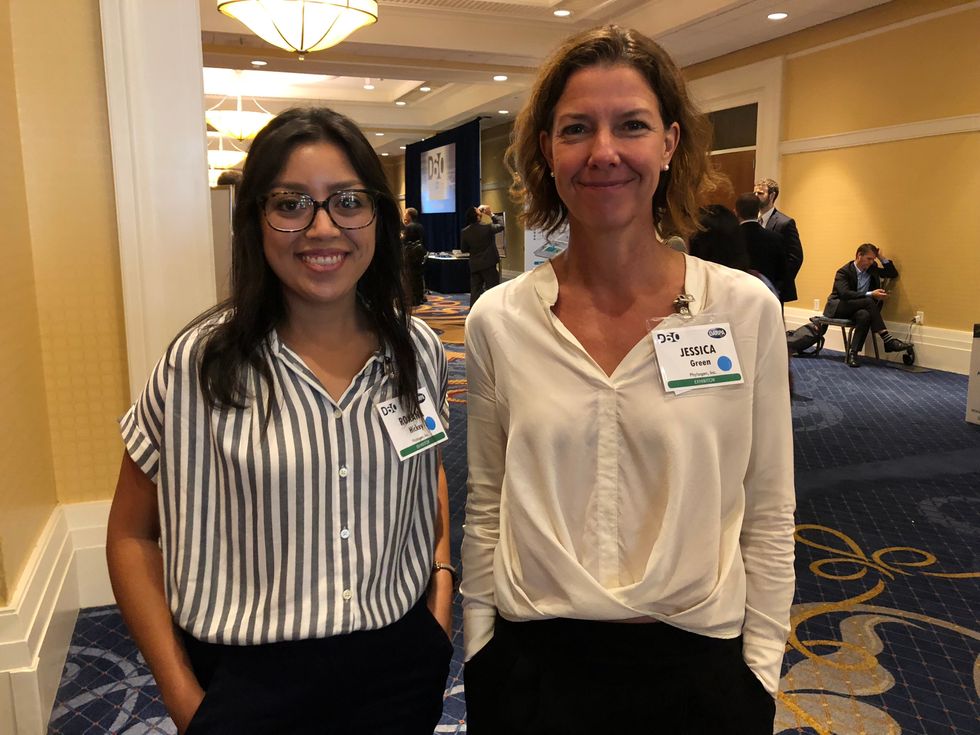This Startup Uses Dust to Fight Sweatshops
Kira Peikoff was the editor-in-chief of Leaps.org from 2017 to 2021. As a journalist, her work has appeared in The New York Times, Newsweek, Nautilus, Popular Mechanics, The New York Academy of Sciences, and other outlets. She is also the author of four suspense novels that explore controversial issues arising from scientific innovation: Living Proof, No Time to Die, Die Again Tomorrow, and Mother Knows Best. Peikoff holds a B.A. in Journalism from New York University and an M.S. in Bioethics from Columbia University. She lives in New Jersey with her husband and two young sons. Follow her on Twitter @KiraPeikoff.

Workers at an industrial textile factory.
"Dust thou art, and unto dust shalt thou return." Whoever wrote that famous line probably didn't realize that dust actually contains a secret weapon.
"We have developed the capability to turn dust into data that can be used to trace problems in the supply chain."
Far from being a collection of mere inanimate particles, dust is now recognized as a powerful tool filled with living sensors. Studying those sensors can reveal an object's location history, which can help brands fight unethical manufacturing.
"We have developed the capability to turn dust into data that can be used to trace problems in the supply chain," explains Jessica Green, the CEO of Phylagen, a San-Francisco-based company that she co-founded in 2014.
So how does the technology work?
Dust gathers everywhere—on our bodies, on objects—and that dust contains microbes like bacteria and viruses. Just as we humans have our own unique microbiomes, research has shown that physical locations have their own identifiable patterns of microbes as well. Visiting a place means you may pick up its microbial fingerprint in the dust that settles on you. The DNA of those microbes can later be sequenced in a lab and matched back to the place of origin.
"Your environment is constantly imprinted on you and vice versa," says Justin Gallivan, the director of the Biotechnology Office at DARPA, the research and defense arm of the Pentagon, which is funding Phylagen. "If we have a microbial map of the world," he posits, "can we infer an object's transit history?"
So far, Phylagen has shown that it's possible to identify where a ship came from based on the unique microbial populations it picked up at different naval ports. In another experiment, the sampling technology allowed researchers to determine where a person had walked within 1 kilometer in San Francisco, because of the microbes picked up by their shoes.
One application of this technology is to help companies that make products abroad. Such companies are very interested in determining exactly where their products are coming from, especially if foreign subcontractors are involved.
"In retail and apparel, often the facilities performing the subcontracting are not up to the same code that the brands require their suppliers to be, so there could be poor working conditions," says Roxana Hickey, a data scientist at Phylagen. "A supplier might use a subcontractor to save on the bottom line, but unethical practices are very damaging to the brand."
Before this technology was developed, brands sometimes faced a challenge figuring out what was going on in their supply chain. But now a product can be tested upon arrival in the States; its microbial signature can theoretically be analyzed and matched against a reference database to help determine if its DNA pattern matches that of the place where the product was purported to have been made.
Phylagen declined to elaborate further about how their process works, such as how they are building a database of reference samples, and how consistent a microbial population remains across a given location.
As the technology grows more robust, though, one could imagine numerous other applications, like in police work and forensics. But today, Phylagen is solely focused on helping commercial entities bring greater transparency to their operations so they can root out unauthorized subcontracting.
Then those unethical suppliers can – shall we say – bite the dust.
Kira Peikoff was the editor-in-chief of Leaps.org from 2017 to 2021. As a journalist, her work has appeared in The New York Times, Newsweek, Nautilus, Popular Mechanics, The New York Academy of Sciences, and other outlets. She is also the author of four suspense novels that explore controversial issues arising from scientific innovation: Living Proof, No Time to Die, Die Again Tomorrow, and Mother Knows Best. Peikoff holds a B.A. in Journalism from New York University and an M.S. in Bioethics from Columbia University. She lives in New Jersey with her husband and two young sons. Follow her on Twitter @KiraPeikoff.
A robot server, controlled remotely by a disabled worker, delivers drinks to patrons at the DAWN cafe in Tokyo.
A sleek, four-foot tall white robot glides across a cafe storefront in Tokyo’s Nihonbashi district, holding a two-tiered serving tray full of tea sandwiches and pastries. The cafe’s patrons smile and say thanks as they take the tray—but it’s not the robot they’re thanking. Instead, the patrons are talking to the person controlling the robot—a restaurant employee who operates the avatar from the comfort of their home.

It’s a typical scene at DAWN, short for Diverse Avatar Working Network—a cafe that launched in Tokyo six years ago as an experimental pop-up and quickly became an overnight success. Today, the cafe is a permanent fixture in Nihonbashi, staffing roughly 60 remote workers who control the robots remotely and communicate to customers via a built-in microphone.
More than just a creative idea, however, DAWN is being hailed as a life-changing opportunity. The workers who control the robots remotely (known as “pilots”) all have disabilities that limit their ability to move around freely and travel outside their homes. Worldwide, an estimated 16 percent of the global population lives with a significant disability—and according to the World Health Organization, these disabilities give rise to other problems, such as exclusion from education, unemployment, and poverty.
These are all problems that Kentaro Yoshifuji, founder and CEO of Ory Laboratory, which supplies the robot servers at DAWN, is looking to correct. Yoshifuji, who was bedridden for several years in high school due to an undisclosed health problem, launched the company to help enable people who are house-bound or bedridden to more fully participate in society, as well as end the loneliness, isolation, and feelings of worthlessness that can sometimes go hand-in-hand with being disabled.
“It’s heartbreaking to think that [people with disabilities] feel they are a burden to society, or that they fear their families suffer by caring for them,” said Yoshifuji in an interview in 2020. “We are dedicating ourselves to providing workable, technology-based solutions. That is our purpose.”

Shota, Kuwahara, a DAWN employee with muscular dystrophy, agrees. "There are many difficulties in my daily life, but I believe my life has a purpose and is not being wasted," he says. "Being useful, able to help other people, even feeling needed by others, is so motivational."
A woman receives a mammogram, which can detect the presence of tumors in a patient's breast.
When a patient is diagnosed with early-stage breast cancer, having surgery to remove the tumor is considered the standard of care. But what happens when a patient can’t have surgery?
Whether it’s due to high blood pressure, advanced age, heart issues, or other reasons, some breast cancer patients don’t qualify for a lumpectomy—one of the most common treatment options for early-stage breast cancer. A lumpectomy surgically removes the tumor while keeping the patient’s breast intact, while a mastectomy removes the entire breast and nearby lymph nodes.
Fortunately, a new technique called cryoablation is now available for breast cancer patients who either aren’t candidates for surgery or don’t feel comfortable undergoing a surgical procedure. With cryoablation, doctors use an ultrasound or CT scan to locate any tumors inside the patient’s breast. They then insert small, needle-like probes into the patient's breast which create an “ice ball” that surrounds the tumor and kills the cancer cells.
Cryoablation has been used for decades to treat cancers of the kidneys and liver—but only in the past few years have doctors been able to use the procedure to treat breast cancer patients. And while clinical trials have shown that cryoablation works for tumors smaller than 1.5 centimeters, a recent clinical trial at Memorial Sloan Kettering Cancer Center in New York has shown that it can work for larger tumors, too.
In this study, doctors performed cryoablation on patients whose tumors were, on average, 2.5 centimeters. The cryoablation procedure lasted for about 30 minutes, and patients were able to go home on the same day following treatment. Doctors then followed up with the patients after 16 months. In the follow-up, doctors found the recurrence rate for tumors after using cryoablation was only 10 percent.
For patients who don’t qualify for surgery, radiation and hormonal therapy is typically used to treat tumors. However, said Yolanda Brice, M.D., an interventional radiologist at Memorial Sloan Kettering Cancer Center, “when treated with only radiation and hormonal therapy, the tumors will eventually return.” Cryotherapy, Brice said, could be a more effective way to treat cancer for patients who can’t have surgery.
“The fact that we only saw a 10 percent recurrence rate in our study is incredibly promising,” she said.


